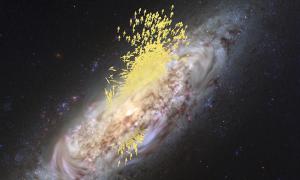Blog
Making Sausage
14 January 2020
 Koppelman, Villalobos and Helmi; NASA/ESA/Hubble
Koppelman, Villalobos and Helmi; NASA/ESA/HubbleThe life of a galaxy can be violent. One day you’re happily spinning with your billions of stars, the next you’re colliding with another galaxy. Galactic collisions can radically change the structure of a galaxy. They can fuel star production, and leave remnants of the collision that last billions of years. Our galaxy has experienced collisions in the past, but how do we piece together the history of these violent interactions?
One of the most powerful tools we have for this research is the Gaia spacecraft. Launched in 2013, Gaia has measured the locations and motions of more than a billion stars in our galaxy. By analyzing the motions of these stars, astronomers found more than 30,000 stars that have highly eccentric orbits. The distribution of these stars is roughly sausage-shaped, and so this became known as the Gaia Sausage.
The motion of these stars is very different from the majority of stars in our galaxy, and it indicates an early collision between our Milky Way and a dwarf galaxy called Gaia-Enceladus. This collision must have occurred billions of years ago when the Milky Way was still relatively young.
Nailing down a more precise date for the collision is a challenge. Recently a team looked at a bright star called ν Indi to figure it out.1 The team looked at the way the star oscillates slightly over time through a process called asteroseismology. The oscillations of a star depend on its interior pressure, density, and temperature. Since these change as a star ages, asteroseismology can be used to determine the age of a main-sequence star. In this case, they found ν Indi is no more than 11.8 billion years old. They also looked at the metallicity of the star, which is a measure of how much heavy elements a star has. Since ν Indi has a low metallicity, it likely formed in the original halo region of the Milky Way, before the collision with Gaia-Enceladus. But the motion of the star has been radically altered by the collision. This means the collision occurred no earlier than 11.5 billion years ago. Other studies date the collision as being no later than about 10 billion years ago.
Chaplin, W.J., et al. “Age dating of an early Milky Way merger via asteroseismology of the naked-eye star ν Indi” Nature Astronomy (2020) ↩︎